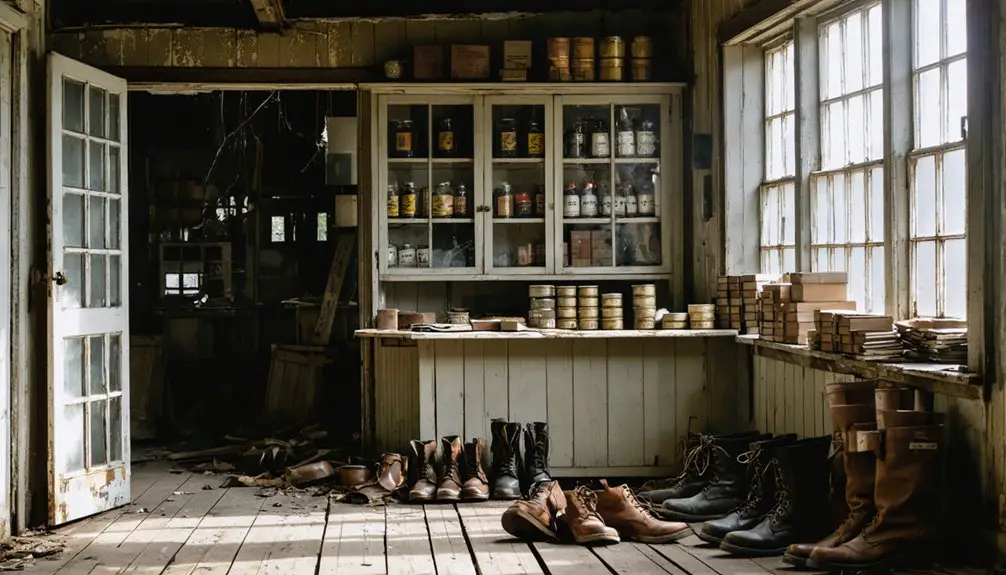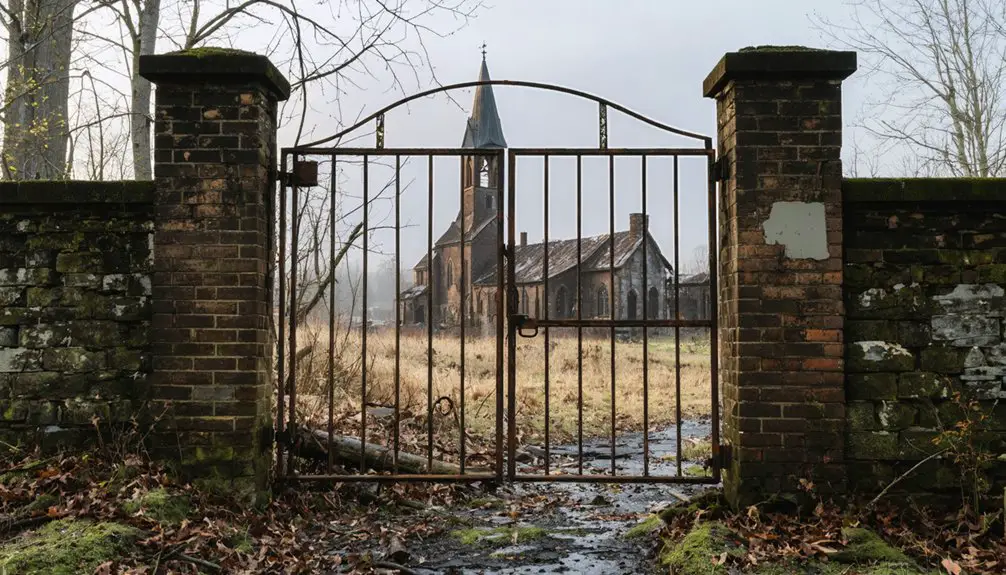You’ll find Eleanora, Pennsylvania’s haunting remains near Punxsutawney, where a bustling coal mining town of 2,700 residents once thrived. Established in 1887 by Rochester & Pittsburgh Coal & Iron Company, the community flourished around its 500-coke oven operation until economic decline and industrial changes forced its abandonment. A devastating underground coal fire that began in 1962 sealed the town’s fate, transforming this once-prosperous settlement into an environmental hazard with a fascinating story to uncover.
Key Takeaways
- Eleanora was established in 1887 as a coal mining town near Punxsutawney, Pennsylvania, reaching a peak population of 2,700 residents.
- The town’s decline began in the early 20th century due to depleted coal seams and reduced demand for coke in steel manufacturing.
- An underground coal fire starting in 1962 created toxic emissions and sinkholes, making the area uninhabitable.
- The community’s history is preserved through artifacts and records at the Jefferson County Historical Society Museum.
- Former residents maintain connections through reunions and online forums, despite the town’s physical abandonment.
The Rise of a Coal Mining Community
When the Rochester & Pittsburgh Coal & Iron Company established Eleanora in 1887, they launched what would become a pivotal coal mining community in Jefferson County, Pennsylvania. Named after Eleanora Iselin, wife of chief investor Adrian Iselin, Sr., the settlement quickly took shape with the construction of 80 company houses in 1888. During this period, miners faced ongoing challenges with wages, as demonstrated by the Monongahela Valley strike of 1848.
The community’s growth accelerated as laborers and their families moved in, drawn by the promise of work at the site’s impressive 500-coke oven operation. Shortly after opening in December 1889, the facility was producing 100,000 tons of coke annually.
You’ll find that Eleanora’s strategic location, just two miles from Punxsutawney, positioned it perfectly within a bustling coal region. The labor dynamics centered around thousands of workers who powered the mines and coking facilities, producing coal that would fuel industrial growth across the Great Lakes region and as far as Chicago.
Life in Early Eleanora
The bustling streets of early Eleanora reflected a tight-knit community where nearly 2,700 residents lived, worked, and built their lives around the coal mining industry.
You’d find paved roads leading to modest homes, where miners and their families settled close to the mine sites for convenient access to their work.
Community gatherings centered around the local church, while fraternal organizations like the Independent Order of Odd Fellows provided social support and mutual aid networks.
The town’s daily rhythm followed the mining schedules, with locals frequenting the shops and service providers that lined the streets.
Life in Eleanora pulsed with the mining industry’s heartbeat as residents moved between work shifts and local businesses.
Children attended nearby schools while their parents worked, and families often congregated at communal spaces.
Like the now-abandoned anthracite coal deposits that sustained many Pennsylvania mining towns, Eleanora’s rich mineral resources were the foundation of its prosperity.
The Odd Fellows Cemetery served as both a cultural landmark and a representation of the strong bonds that united Eleanora’s residents.
Much like modern-day Centralia, where only five citizens remained by 2010, the town would eventually face significant population decline.
Economic Decline and Industrial Changes
Despite Eleanora’s early industrial success, significant economic changes began reshaping the town’s fortunes by the early 20th century.
You’d have witnessed a dramatic economic shift as coal seams became depleted and steel manufacturing technology evolved, reducing demand for the town’s once-prized coke. The industrial legacy of Eleanora’s 100,000-ton annual coke production couldn’t sustain itself against larger, more diversified operations near urban centers. Like many communities, workers faced restrictive yellow dog contracts that prevented unionization and labor protections.
Like other mining communities, Eleanora was devastated by World War I and its aftermath. The Great Depression dealt another blow, accelerating the town’s decline.
You would’ve seen how changes in rail transportation and industrial consolidation created a devastating cycle – as major corporations divested from isolated sites, essential services disappeared. The company town model that had once brought prosperity to Eleanora now worked against it, leaving the community vulnerable to abandonment as industries centralized elsewhere.
Notable Buildings and Structures
Walking through Eleanora today, you’ll find a haunting collection of deteriorating structures that tell the story of this once-thriving mining community.
The town’s notable architecture includes brick industrial buildings with massive walls and A-frame supports, remnants of the Eleanora Mines and Coke Works operations. A closer look reveals abandoned water treatment tanks still partially filled decades after closure. You’ll notice remaining houses, originally built in rows, now requiring external buttresses to maintain structural integrity after their neighboring buildings were demolished. Like Centralia, the ground beneath these structures releases toxic gases and smoke from deep underground.
Hidden beneath natural overgrowth, you can spot fragments of the original town layout through exposed foundations and broken sidewalks.
While most community buildings have vanished, a few churches still stand as silent witnesses to Eleanora’s past. The town’s transformation is evident in the apple trees now planted where homes once stood, nature slowly reclaiming this industrial ghost town.
The Exodus of Residents
Throughout the 1960s and early 1970s, life in Eleanora gradually ground to a halt as residents began abandoning their homes and businesses.
You’ll find that the exodus began much like Centralia’s, with families making individual choices to leave as safety concerns mounted. Local evacuation procedures evolved from voluntary departures to structured buyout programs.
Resident testimonies from the era paint a picture of a community torn between staying and leaving, mirroring Centralia’s painful shift. A 12-year-old boy’s fall into a dangerous sinkhole in 1982 accelerated the exodus of worried families.
Pennsylvania invested millions in funding to assist with relocation efforts and property acquisitions.
Just as Centralia’s population plummeted from 2,000 to fewer than 100 by the 1990s, Eleanora experienced a similar dramatic decline.
Property values collapsed as more families departed, creating a snowball effect that accelerated the town’s abandonment.
Today, like Centralia, Eleanora stands largely empty, its remaining structures slowly reclaimed by nature.
Environmental Impact and Challenges
The underground coal fire that began at Eleanora’s landfill in 1962 released a cascade of devastating environmental consequences that would plague the region for decades.
You’ll find that toxic emissions, including carbon monoxide, sulfur dioxide, and methane, seeped through ground fissures into residential areas, creating severe environmental hazards. The fire’s intense heat destabilized the soil, leading to dangerous sinkholes and ground subsidence that made the land uninhabitable.
Toxic fumes seeped through fissures while underground heat created sinkholes, turning residential neighborhoods into an unstable, hazardous wasteland.
The disaster didn’t stop at air pollution – it poisoned the groundwater with heavy metals and turned nearby streams acidic.
You’re looking at contamination levels that reached battery acid toxicity. Despite attempts to extinguish the fire using water and clay, the underground inferno proved unstoppable, creating an environmental catastrophe that continues to threaten public health and ecosystem stability.
Preserved Artifacts and Historical Records

You’ll find carefully curated collections of Eleanora artifacts at the Jefferson County Historical Society Museum, including mining tools, household items, and photographs that showcase daily life in this once-thriving coal town.
The First Presbyterian Church‘s meticulously preserved baptismal and marriage records from 1870-1935 provide valuable genealogical information about the community’s families.
Original mining equipment documentation, including machinery maintenance logs and coal production records, offers detailed insights into the technological and operational aspects of Eleanora’s mining operations.
Museum Collection Highlights
Visitors exploring Eleanora’s museum collection will discover a remarkable assemblage of artifacts chronicling the town’s coal mining heritage and daily life.
You’ll find meticulously preserved mining equipment, including original helmets, lamps, and hand tools that tell the story of underground labor. The museum highlights feature intimate glimpses of domestic life through household items, personal effects, and cultural artifacts that showcase the community’s resilience.
Among the artifact significance, you’ll see rare documents including mining company ledgers, town correspondence, and early census records, all housed in climate-controlled cases.
Interactive displays bring the past to life through recorded oral histories, while 3D digitization allows you to examine delicate items up close.
The collection includes poignant reminders of community life, from school textbooks to festival memorabilia.
Church Record Preservation
Rich collections of church records stand as vital historical treasures in Eleanora’s preservation efforts, documenting the community’s spiritual and social fabric from the mid-18th through early 20th centuries.
You’ll find extensive baptismal and marriage registers from local parishes, including St. Michael, St. Patrick, and St. Teresa of Avila, now preserved in denominational archives and historical centers.
The church history reveals itself through digitized collections, making record accessibility easier for researchers and genealogists. FamilySearch’s database includes valuable records from nearby communities dating back to 1741.
Beyond sacramental records, you’ll discover vestry minutes, sexton’s house records, and property deeds that detail churchyard changes.
These preserved documents provide vital insights into the demographic shifts and social development of this Pennsylvania ghost town.
Mining Equipment Documentation
Beyond church records, tangible remnants of Eleanora’s industrial past survive through an extensive collection of preserved mining equipment and documentation.
You’ll find artifact preservation efforts that showcase pickaxes, drills, and rail tracks once used in anthracite coal extraction. Local historical societies have carefully curated these pieces, protecting them with climate-controlled storage and anti-corrosion treatments.
The mining documentation reveals fascinating technical details through company logs, engineering blueprints, and state inspection reports. You can trace the evolution from manual tools to steam-powered machinery through photographic records and worker testimonials.
While underground fires and environmental factors have destroyed some artifacts, museums continue protecting Eleanora’s mining heritage through educational programs and detailed catalogs, allowing you to explore this vital chapter of Pennsylvania’s coal mining history.
Stories From Former Residents

Through decades of personal accounts, the former residents of Eleanora have painted a vivid picture of their town’s tragic decline from a thriving coal mining community of 2,000 people to an abandoned ghost town.
Their personal anecdotes and community memories reveal the heartbreaking transformation of their beloved hometown.
- Former neighbors maintained connections through reunions and online forums, sharing stories of life before the evacuation.
- Many residents fought legal battles to keep their ancestral homes, resulting in decades-long court disputes.
- The community formed support networks to help each other cope with displacement and loss.
- Families struggled with the emotional trauma of leaving behind generations of history, watching their homes get demolished.
The raw emotion in these accounts captures the deep bond between residents and their vanished community.
The Ghost Town Today
While Eleanora’s decline seems irreversible, approximately five residents still call this ghost town home in 2025, living under a unique agreement that allows them to stay until death.
You’ll find most buildings demolished or abandoned, with cracked streets overtaken by vegetation and damaged infrastructure scattered throughout the landscape.
The current conditions reflect decades of destruction from the underground coal fire that burns beneath 3,700 acres.
You can spot smoke and steam rising from ground fissures, while venting tubes pierce the earth to relieve pressure.
Though some surrounding forest shows signs of recovery, the immediate area remains unstable and hazardous.
The once-popular Graffiti Highway lies buried under dirt since 2020, though urban explorers continue to visit accessible parts of this haunting landscape.
Frequently Asked Questions
Are There Any Paranormal Activities Reported in Abandoned Eleanora Buildings?
You won’t find any confirmed ghost sightings or haunted locations in Eleanora’s buildings. Unlike Centralia, there aren’t any documented paranormal reports or investigations connected to this abandoned town’s structures.
What Happened to the Mining Equipment After the Town Was Abandoned?
You’d be amazed how quickly mining equipment vanished – most was salvaged for scrap value or transferred to other mines, while some heavier machinery was simply abandoned in this ghost town’s deteriorating tunnels.
Did Any Families Choose to Stay After the Mass Exodus?
You’ll find remarkable family stories of survival: around five residents remained by 2010, defying evacuation orders. They fought legal battles to keep their homes, with only two or three families still there today.
Were There Any Major Accidents in Eleanora’s Mines During Operations?
Your ancestors faced death daily in those dark shafts. The worst historical accident was a devastating 1905 mine explosion that instantly killed 13 miners, raising serious concerns about mine safety practices.
What Valuable Artifacts Have Been Discovered by Urban Explorers in Eleanora?
You won’t find reports of valuable artifacts from urban exploration in Eleanora. Discoveries are limited to common structural remains like wooden supports, brick walls, and scattered industrial debris from abandoned buildings.
References
- https://pabucketlist.com/the-rise-and-fall-of-centralia-pas-toxic-ghost-town/
- https://www.youtube.com/watch?v=BlioLNgiKCk
- https://www.youtube.com/watch?v=aCMVl6iCA78
- https://allthatsinteresting.com/centralia-pa
- https://www.youtube.com/watch?v=Kp3_s-rAVXw
- https://www.iup.edu/library/departments/archives/coal/mining-history/history-of-coke.html
- http://iiif.library.cmu.edu/file/Heinz_box00022_fld00006_bdl0005_doc0006/Heinz_box00022_fld00006_bdl0005_doc0006.pdf
- https://www.iup.edu/library/departments/archives/coal/coal-culture-timeline.html
- https://www.psu.edu/news/institutes-energy-and-environment/story/created-due-mining-accident-pa-mine-map-atlas-has-served
- https://www.hmdb.org/m.asp?m=281919



